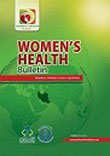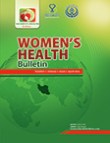فهرست مطالب

Women’s Health Bulletin
Volume:3 Issue: 1, jan 2016
- تاریخ انتشار: 1394/10/22
- تعداد عناوین: 7
-
-
Page 1BackgroundWith the global rise of individuals classified as overweight and obese, weight-related screenings have been promoted to combat their high prevalence and associated health problems. Hopefully, such screenings can act as a ‘trigger’ for health behavior change, however little is known about the experience of weight loss triggers..ObjectivesThe aim of this study was to elaborate on the experiences and meanings of weight-control triggers in a sample of overweight women prescribed by their physician to lose weight..Patients andMethodsWe conducted exploratory qualitative interviews, grounded in phenomenological practices, to elaborate on the experience and meaning of weight loss ‘triggers’ in a sample of overweight, female patients prescribed to lose weight by their physician..ResultsWeight-related screenings can act as a ‘trigger’ for health behavior change. Overall, we discovered five novel themes that embodied patients’ complex experiences with triggers: (1) trigger realization, (2) trigger meaning, (3) knowing what to do, (4) perceptions of self, and (5) the good, the bad, the monitoring..ConclusionsWe believe our findings advance the novel understanding of experiences with triggers. Specifically, our work sheds light on why triggers occur, and can guide how to create and manage both realized and meaningful triggers for healthy behavior change. The present results suggest that trigger realization can come from several different sources (e.g. medical, emotional, clothing, social), yet women are capable of deflecting any potential trigger experience. In addition, our findings suggest multiple facets of self-monitoring experiences can actually be counterproductive in weight control. The results provide insight for primary care, weight control counseling, and future interventions for triggered patients..Keywords: Body Weight, Weight Loss, Screening, Body Image
-
Page 2BackgroundTo our knowledge, no reports are available indicating the effects of synbiotics on pregnancy outcomes and maternal biochemical indices in pregnant women..ObjectivesThis study was designed to evaluate the effects of daily consumption of a synbiotic food on pregnancy outcomes and maternal biochemical indices among Iranian pregnant women..Patients andMethodsThis double-blind randomized controlled clinical trial was conducted among 52 pregnant women, primigravida, aged from 18 to 35 years with singleton pregnancy at their third trimester. After a 2-week run-in period, pregnant women were divided into two groups to receive either a synbiotic (n = 26) or control food (n = 26) for 9 weeks randomly. The synbiotic food contained a probiotic viable and heat-resistant Lactobacillus sporogenes (1 × 107 CFU) and 0.04 g inulin (HPX)/g as the prebiotic. Subjects were requested to consume the synbiotic food two times a day in 9 g portions, followed by checking for newborn’s weight, height, head circumference, Apgar score, and hyperbilirubinemia. Fasting blood samples were taken at the beginning of the study and 9 weeks after the intervention to measure serum calcium, iron, and magnesium and liver enzymes..ResultsSupplementation with synbiotic food for 9 weeks among pregnant women did not affect any significant differences in the cesarean section rate, gestational age, newborn birth size and Apgar score. Synbiotic-supplemented women had a significant rise in serum calcium levels (+0.2 ± 1.0 vs. -0.5 ± 0.8 mg/dL, P = 0.005) compared to women in the control group, while no significant differences were found between the two groups in terms of their effects on serum iron, magnesium and liver enzymes levels..ConclusionsTaken together, consumption of synbiotic food among pregnant women for 9 weeks has resulted in increased levels of serum calcium compared to the control food, but did not affect pregnancy outcomes, serum iron, magnesium and liver enzymes..Keywords: Synbiotics, Pregnancy Outcome, Calcium, Iron, Liver Enzymes, Pregnant Women
-
Page 3BackgroundMenarche is a woman’s first menstruation and is determined by multiple factors..ObjectivesThe aim of this study was to evaluate the effect of exercise on the age of menarche in girls at guidance schools of Shiraz, Iran..Patients andMethodsThis cross-sectional study attempted to evaluate the effect of regular exercise on the age of menarche in relation to demographic data in 483 randomly selected girls from guidance school in Shiraz, Iran, using statistical analysis including independent t-test, variance analysis and linear regression tests..ResultsParticipants were divided in two groups including 181 and 302 athletic and non-athletic girls, respectively. A statistically significant difference was found in the mean age at menarche between athletic 12.4 ± 0.9 SD and non-athletic girls 12.1 ± 1.0 SD years (P = 0.003). Linear regression indicated that mother’s age (P = 0.049) and exercise (P = 0.001) both have significant association with age at menarche..ConclusionsThe age at menarche for the athletic group was significantly delayed. Exercise and mother’s age were significantly associated with age at menarche, whereas no significant association was observed between age at menarche and weight, BMI, father’s age, and mother’s and father’s educational levels..Keywords: Exercise, Age, Shiraz, Menarche, Iran
-
Page 4Context: Social relations have been found to affect different aspects of people’s life. This article is a systematic review of attempts to consider the social support as a major determinant of health during life span..Evidence Acquisition: For our research we retrieved data from the J Store, Springer, Wiley Online Library, Elsevier, Science Direct, PubMed database as well-known sources of scientific studies. The study comprised all studies considering social ties and relationships and health outcomes of both genders in different aspects of medical sociology and social epidemiology, with particular emphasis on comprehensive studies to identify the implications of and the effect of social support on women’s health..ResultsThe results obtained from this review are presented in three main sections. These include perceived versus received social support, main effect versus buffering effect of social support, and finally the consideration of women’s health. Overall, empirical studies confirm the importance of social relationship to health and longevity and its different implications in women’s health..ConclusionsTo be healthier and more usefully active in the society, women need to have different kinds of support from social relationships. Women are required to be better informed about the significance of enjoying positive social relationships which provide potential health benefits, by social support, from both relatives and other people..Keywords: Social Support, Health, Women, Medical Sociology
-
Page 5BackgroundAlthough exercise is recommended for preventing gestational diabetes mellitus (GDM), the situation has remained unclear regarding the characteristics and timing of the proper exercise..ObjectivesThe aim of the present study was to compare exercise characteristics including volume, frequency, intensity and energy expenditure before and during pregnancy in diabetic and non-diabetic pregnant women..Patients andMethodsParticipants of the study included 137 pregnant women (80 diabetics and 57 non-diabetics) who were selected based on the inclusion criteria. Exercise activities of the participants were evaluated by interviews. Statistical tests of Mann-Whitney and Chi-square were used for data analysis..ResultsParticipating in regular exercise activities was significantly higher in the non-diabetics compared to the diabetics during all stages including 8 and 1 years before pregnancy and during the 1st and 2nd trimesters of pregnancy (P < 0.05). However among the diabetics and non-diabetics who regularly exercised, there was no significant difference in terms of exercise characteristics (frequency, intensity, duration and energy cost)..ConclusionsRegular participation in exercise activities before and during pregnancy especially during the second trimester is important for preventing GDM. However, in few cases, similar exercise characteristics were found among diabetics and non-diabetics..Keywords: Gestational Diabetes, Exercise Characteristics, Energy Expenditure
-
Page 7BackgroundOver the last decades youth suicide has been recognized as a significant public health problem. Efforts have been intensified to understand suicidal continuum; from suicide ideation to committing suicide..ObjectivesThis study sought to examine the predictive role of self-oriented/other-oriented perfectionism, goal reengagement, that increase psychological well-being and goal disengagement and reduce distressing psychological resources, on suicidal ideation among university students..Materials And MethodsThis study comprised 310 female university students with mean age of 21.37 years, selected via multi stage random sampling method. All subjects were asked to complete multidimensional perfectionism scale (MPS), goal adjustment scale (GAS) and Beck suicidal ideation (BSI). The data analysis was performed using correlation and stepwise regression methods..ResultsThe results obtained showed significant correlations between self-oriented perfectionism and goal reengagement with suicidal ideation..ConclusionsConsidering the prediction of female students’ suicide ideation by self-oriented perfectionism, other-oriented perfectionism and goal reengagement, further studies are needed in regard to design training and preventing programs in order to reduce the negative effects of perfectionism..Keywords: Perfectionism, Goal Adjustment, Suicidal Ideation, Students


